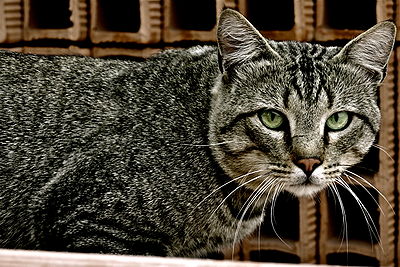So I had to buy a new car because my old one was literally falling apart. So I picked it up yesterday, and this was after I had to drop off the cat mobile Jeep for $600+ in repairs. I am praying I get another 100,000 miles out of the Jeep, I can't afford another. Jeep still in shop, so had to take the very new vehicle into the hood this morning. Still didn't know how to use all the bells and whistles in it, so was a bit nervous about it. But figured it out. All the kitties fed, but its also quite cold out. 19 degrees. We are in for another storm, but they can't predict if it will be snow or rain. I would prefer snow any day over rain.
Parsley is adjusting nicely. I've left the gate to the room he is in open so he can explore. So far, no sign of aggression from him towards the other cats, and none from them, just curious. He loves to lay with you and get petted and scratched. Just a really nice cat. Its shocking to realize how many 'really nice cats' are out there on the streets still.
This morning, at 3rd and Central, little white and black kitty came running to me. I have not seen that cat in a few weeks now, since I rescued Cuddles. This is another one I know would make a wonderful pet. Its so hard to leave them.
Again, I leave you with some interesting facts about our four legged friends.
Touch]
A cat has about twenty-four movable vibrissae ("whiskers"), in four sets on each upper lip on either side of its nose (some cats may have more). There are also a few on each cheek, tufts over the eyes, bristles on the chin, the cat's inner "wrists", and at the back of the legs. The Sphynx (a nearly hairless breed) may have full length, short, or no whiskers at all.
The structure of the brain region (barrel cortex) which receives information from the vibrissae is similar to that found in the visual cortex which permits the cat to create a three-dimensional map of its surroundings. This doesn't mean that sensing with vibrissae is a type of vision. It is still a touch sensation and environmental information is built up incrementally (in small steps).
Vibrissae aid sensation and navigation. The upper two rows of whiskers are able to be moved independently from the lower two rows for greater precision during measurement. A cat's whiskers are more than twice as thick as ordinary cat hairs, and their roots are three times deeper in a cat's tissue than other hairs. They have numerous nerve endings at their base, which give cats extraordinarily detailed information about nearby air movements and objects with which they make physical contact. They enable a cat to know that it is near obstacles without it needing to see them.
Whiskers also aid in hunting. High speed photography reveals that when a cat is unable to see its prey because it is too close to its mouth, its whiskers move so as to form a basket shape around its muzzle in order to precisely detect the prey's location. A cat whose whiskers have been damaged may bite the wrong part of its prey, indicating that they provide cats with detailed information about the shape and activity of its prey.
"When you've reached the end of your rope,
tie a knot and hang on."




I will share a story! :) - Kristin
ReplyDeleteI fear that the story of my 2 rescued kitties would be boring and my writing skills are weak.
ReplyDeleteCarolyn,
DeleteGuarantee you that your rescue stories will not be boring. So please share them with us. As far as the other point goes none of us are English Majors. So do not concern yourself about that trivial matter.
Walt Simoni